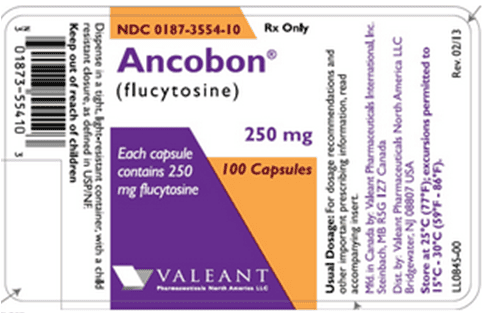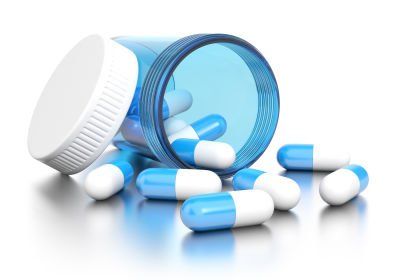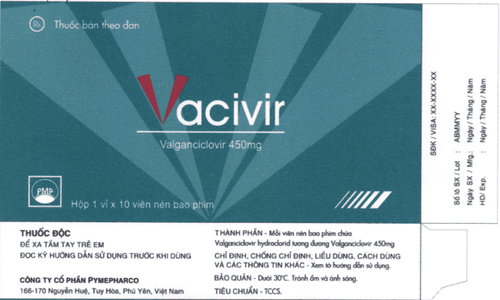This is an automatically translated article.
Valgan medicine has the main ingredient Valganciclovir, which is made in the form of tablets. The drug is indicated for the treatment of retinitis caused by cytomegalovirus (Cytomegalovirus-CMV) in patients with acquired immunodeficiency syndrome (AIDS). important when using the drug in the article below.
1. What is Valgan?
Valgan medicine has the main ingredient Valganciclovir (in the form of Valganciclovir hydrochloride) 450mg and other excipients just enough for 1 tablet. Valgan is manufactured by Cipla Ltd - India, circulated in our country with VN3-213-19. Valgan is prepared in the form of tablets, packing is a box of 1 HDPE bottle of 60 tablets; Box of 1 blister of 4 tablets.
Valganciclovir is a prodrug of ganciclovir with improved bioavailability. Ganciclovir is a synthetic analogue of 2-deoxyguanosine. Once phosphorylated, ganciclovir triphosphate inhibits viral DNA synthesis.
2. Indications and contraindications of the drug Valgan
Valgan is indicated for the treatment of the following conditions:
Cytomegalovirus (CMV) retinitis in patients with acquired immunodeficiency syndrome (AIDS). Prevention of cytomegalovirus (CMV) diseases in organ transplant patients at risk of CMV infection. The use of Valgan is contraindicated in the following cases:
Patients with known hypersensitivity to ganciclovir, valganciclovir or to any of the components of the drug Valgan Cross-reactivity between valcyte, aciclovir, valganciclovird may occur due to compatibility. about chemical structure
3. Dosage of the drug Valgan
3.1. How to use: Use Valgan by mouth and should be taken with food It is necessary to strictly adhere to the dose and method of taking Valgan, because Valcyte is rapidly and extensively metabolized to ganciclovir. Valgan tablets should not be broken or crushed, as Valganciclovir is considered a potential teratogen and carcinogen in humans. Therefore, caution should be exercised when using broken Valgan tablets. Direct contact with broken or crushed tablets should be avoided with mucous membranes and skin. Wash thoroughly with soap and water, if contact occurs. 3.2. Dosage: Initial treatment of cytomegalovirus retinitis:
In patients with active CMV retinitis:
The recommended dose is 900 mg (2 450 mg tablets), twice daily days in 21 days. Prolonging the starting dose may increase the risk of bone marrow toxicity. Maintenance therapy of cytomegalovirus retinitis
After initial therapy, or in patients with inactive CMV retinitis:
The recommended dose of Valgan is 900 mg (2 tablets of 450 mg) 1 time per day. The starting dose may be restarted in patients with worsening retinitis Prophylaxis of cytomegalovirus in transplant patients
For organ transplant patients:
The recommended dose of Valgan is 900 mg (2 tablets of 450 mg) ) once daily Use within 10 days of transplant until 100 days after transplant. For patients with renal impairment: Careful monitoring of serum creatinine or creatinine clearance is required and the dose adjusted according to creatinine clearance.
For patients on hemodialysis: The recommended dose is not applied to patients on hemodialysis (CrCl < 10ml/min) so Valcyte should not be used in these patients.
For patients with anemia, severe neutropenia, thrombocytopenia and pancytopenia: neutropenia, severe leukopenia, anemia, thrombocytopenia and pancytopenia, Aplastic anemia and bone marrow suppression have been reported in patients treated with Valcyte (and ganciclovir). Therefore, if the neutrophil count is less than 500 cells/mcl or the platelet count is below 25000/mcl or the hemoglobin is less than 8g/dl, treatment should not be initiated.
For the elderly: Safety and effectiveness of Valgan have not been established in the elderly.
For Children: The safety and efficacy of Valganciclovir in pediatric patients have not been established in appropriate and well-controlled clinical trials.
3.3. Treatment of Overdose: There have been several reports of an adult dying from severe myelosuppression (marrow aplasia) after a few days of taking Valgan at doses at least 10 times the recommended dose for patients. renal failure. Patients should be aware that overdosage of valganciclovir may also increase nephrotoxicity. Water balance and hemodialysis may also be helpful in reducing plasma concentrations of patients receiving valganciclovir overdose If you use Valgan in excess of the prescribed dose and have unusual symptoms, you should immediately contact the nearest medical facility.
4. Side effects of the drug Valgan
During the use of Valgan medicine, there may be some specific side effects as follows:
Digestive system disorders: dyspepsia, dysphagia, belching, bowel incontinence, abdominal distention, cholangitis, esophagitis, flatulence, digestive disorders, gastritis, gastrointestinal bleeding, pancreatitis, mouth ulcers, tongue disorders. Systemic: asthenia, ascites, bacterial, fungal and viral infections, fatigue, pain, photosensitivity, bleeding, mucosal disorders, chills, infection. Hepatic system disorders: jaundice, dermatitis Skin and adnexal disorders: urticaria, dry skin, alopecia, profuse sweating Central and peripheral nervous system disorders: anxiety, coma, dry mouth confusion, ataxia, affective disorder, hyperactivity syndrome, somnolence, increased muscle tone, decreased sex drive, nervousness, abnormal thinking. Musculoskeletal system disorders: myasthenia gravis, musculoskeletal pain Urinary system disorders: renal failure, hematuria, impotence, urinary frequency. Metabolism and nutrition disorders: blood creatine phosphokinase increased, blood alkaline phosphatase increased, blood glucose decreased, blood lactic dehydrogenase increased, hypoproteinaemia, diabetes mellitus. The senses: eye bleeding, eye pain, decreased vision, blindness, ear pain, deafness, headache, sinusitis, taste disturbance, visual abnormalities, vitreous disorders. Blood and lymphatic system eosinophilia, leukocytosis, splenomegaly, lymphadenopathy. Cardiovascular system disorders: migraine , phlebitis, arrhythmias (including ventricular arrhythmias), tachycardia, vasodilatation, thrombophlebitis, vasodilatation. Respiratory system disorders: sinus congestion.
5. Be careful when taking Valgan
During the use of Valgan, patients should pay attention to the following issues:
In animal studies, ganciclovir was found to be mutagenic, teratogenic, carcinogenic and fertility-reducing. sperm. Valganciclovir should therefore be considered for potential teratogenicity and human carcinogenicity with potential for neonatal disability and carcinogenicity. Patients should be cautious when using the drug because Valganciclovir temporarily or permanently inhibits spermatogenesis. Neutropenia, severe leukopenia, anemia, thrombocytopenia, pancytopenia, aplastic anemia, and bone marrow suppression have been reported in patients treated with valganciclovir (and ganciclovir). . Treatment with Valgan should not be initiated if the neutrophil count is below 500/mcl or the platelet count is below 25000/mcl or the hemoglobin is less than 8g/dl. Valganciclovir is not recommended for use in children. The bioavailability of ganciclovir from Valganciclovir is up to 10 times higher than that from ganciclovir capsules. Valganciclovir is not a substitute for ganciclovir capsules on a 1:1 basis. Therefore, patients switching from ganciclovir capsules should be careful to avoid the risk of overdose if they take more than the prescribed number of Valganciclovir tablets. Platelet and whole blood cell counts should be monitored during treatment. Dosage adjustment is required in patients with renal impairment, based on creatinine clearance. The recommended dose is not applied to patients on hemodialysis (CrCl < 10 ml/min). Therefore, Valganciclovir should not be used in these patients. Valganciclovir should not be used concomitantly with imipenem-cilastatin unless the potential benefits outweigh the potential risks. Valganciclovir and zidovudine both carry a risk of anemia and neutropenia. Some patients cannot tolerate concomitant full-dose combination regimens. When co-administered with Valganciclovir, didanosine plasma concentrations may be increased. Therefore, these patients should be closely monitored for didanosine toxicity. Concomitant administration with other drugs known to cause myelosuppression or renal failure with valganciclovir may increase toxicity. Patients being treated with Valganciclovir and/or ganciclovir may experience convulsions, drowsiness, dizziness, etc., which will affect the patient's ability to drive and use machines. Avoid the use of Valganciclovir in pregnant women unless the potential benefits to the mother outweigh the potential risks to the fetus. For women of childbearing potential, effective contraception should be advised during Valgan treatment. For male patients, contraception should be advised during and after treatment with Valganciclovir for at least 90 days. Perinatal and postnatal development have not been studied with ganciclovir or with valganciclovir but the possibility that ganciclovir is excreted in human milk and causes serious adverse reactions in the neonate cannot be excluded. Therefore, the decision to discontinue therapy or to discontinue breast-feeding must be weighed against the potential benefit of valganciclovir to a nursing mother.
6. Valgan drug interactions
Valganciclovir : Valganciclovir is metabolized to ganciclovir, so the drug interaction characteristics of ganciclovir are also taken into account for valganciclovir. Ganciclovir: Ganciclovir is 1-2% bound to plasma proteins and drug interactions involving competition for binding sites are excluded. Imipenem-cilastatin: Convulsions have been reported in patients receiving concomitant ganciclovir and imipenem-cilastatin. Probenecid: Close monitoring of ganciclovir toxicity is required in patients receiving probenecid and valganciclovir. Zidovudine: ganciclovir and zidovudine can cause neutropenia and anemia, some patients may not be able to tolerate concomitant therapy at adequate doses. Didanosine: Plasma concentrations of didanosine were observed to be consistently increased with ganciclovir administration (both oral and intravenous). Therefore, patients should be closely monitored for didanosine toxicity when co-administered. Mycophenolate mofetil: Concomitant administration of these two drugs increases the phenolic glucuronide of mycophenolic acid (MPAG) and ganciclovir concentrations. Other Potential Drug Interactions: Toxicity may be increased when ganciclovir is co-administered with other drugs known to suppress bone marrow or in combination with renal impairment (such as pentamidine, dapsone, flucytosine, vinblastine, vincristine, amphotericin). B, adriamycin, nucleoside analogues and hydroxyurea). Therefore, consideration should be given to ganciclovir with these agents if the potential benefits outweigh the potential risks. In the process of using Valgan, patients need to pay attention to follow the doctor's instructions, carefully read the notes before taking to be able to bring the highest treatment effect, limit possible side effects. happen.













